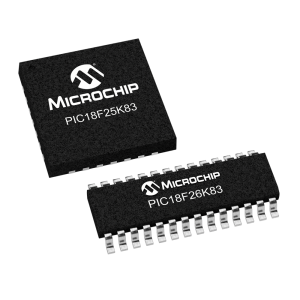Microchip’s PIC18 product line has been expanded to include a new line of 8-bit microcontrollers (MCUs) that combine a Controller Area Network (CAN) bus with an extensive array of Core Independent Peripherals (CIPs). The CIPs increase system capabilities while making it easier for designers to create CAN-based applications without the complexity of added software.
A key advantage of using a K83 MCU in CAN-based systems is that the CIPs provide deterministic response to real time events, shorten design time and can be easily configured through the MPLAB Code Configurator (MCC) tool. The new family is ideal for applications using CAN in the medical, industrial and automotive markets, such as motorised surgical tables, asset tracking, ultrasound machines, automated conveyors and automotive accessories. System designers can benefit greatly by saving time, as it is significantly easier to configure a hardware-based peripheral, as opposed to writing and validating an entire software routine, to accomplish a task.
“Being able to configure an MCU with a few clicks within MCC will change the way you design with CAN,” said Steve Drehobl, vice president of Microchip’s 8-bit MCU business unit. “The CIPs in the K83 family make it easier to use communications, intelligent analog and low-power features with the same tool set as with other PIC microcontrollers.”
The PIC18 K83 devices contain 15 time-saving CIPs including: Cyclic Redundancy Check (CRC) with memory scan for ensuring the integrity of non-volatile memory; Direct Memory Access (DMA) enabling data transfers between memory and peripherals without CPU involvement; Windowed Watchdog Timer (WWDT) for triggering system resets; 12-bit Analog-to-Digital Converter with Computation (ADC2) for automating analog signal analysis for real-time system response; and Complementary Waveform Generator (CWG) enabling high-efficiency synchronous switching for motor control.
For more information visit: www.microchip.com/k83










